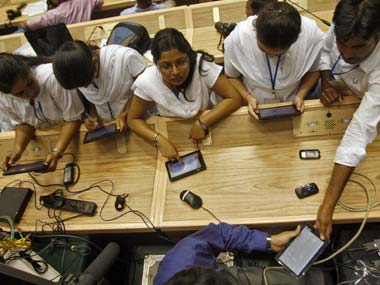President and CEO of OLPC (One Laptop Per Child)India Foundation, Satish Jha, has been vocally critical of the Indian government’s Aakash tablet project, pointing out the device’s weaknesses. But the OLPC project recently announced its own tablet project, which will compete with the Aakash. So are Jha’s criticisms fair?
In an article for the Economic Times, Jha writes off the Aakash as a product of deluded dreamers who are out of touch with the realities of technology product development. India, he says, is incapable of producing the Aakash, and certainly not at the price of USD 35.
The government is, of course, subsidising the Aakash by about 50%, meaning that we are really talking about a USD 70 tablet. There are plenty of low-end smartphones that come in under the USD 70; it would be fair to think of the Aakash as a low-end smartphone-like device with a big screen. It is not an iPad challenger.
[caption id=“attachment_194911” align=“alignleft” width=“380” caption=“Any device with access to the Internetcanbe a powerful learning device.Reuters”]  [/caption]
Jha also dismisses the Aakash because it is a tablet, not a laptop:
“Tablets can hardly replace computers, especially for those who need to create documents, or do anything that demands a little more action, than responding to a process.”
Yet OLPC announced its own tablet at CES this year. Wired said:
“OLPC’s XO 3.0 tablet is encased in lime green plastic like its laptop counterpart. It has a solar panel cover that can generate four watts of power (which delivers two hours of usage) after charging for an hour. It can also be powered using a hand-cranked power supply. Six minutes of cranking will net you two watts of power, or one hour of usage.
The price for OLPC’s tablet hasn’t officially been announced, but rumors peg it at $100 or less.”
Indeed, we learn from the EFY Times that Jha is “is trying to make the [OLPC] tablet available for Indian students,” so he can’t be that anti-tablet.
Further criticisms from Jha: that Aakash is “a dysfunctional device that has little to do with education or learning.”
Is the Aakash dysfunctional? Certainly, the first version has disappointed reviewers and students. IBNLive found three main problems with the Aakash:
1. The screen is rather unresponsive. Sometimes I had to push the screen really hard to get a response.
2. It also heats up really fast. Which means in the heat and dust of India, it could face problems.
3. It connects to the internet only using Wi-Fi. Which means if a student is travelling or in a room that doesn’t have Wi-Fi, he’s stumped.
To be fair, any tablet will have an issue with connectivity in places without wi-fi. And, given the well-publicised problems with 3G connectivity across India, the lack of mobile data probably isn’t that big of an omission at this point.
But some of the Aakash’s problems will hopefully be solved in April when the Aakash 2 comes out. The Hindustan Times says:
“The Aakash 2 tablet will [be] three times faster than Aakash 1 and will have 50% more battery life. The latest version will have to pass a new quality protocol prepared on basis of inputs received from around 600 students of IITs and engineering colleges.”
It remains to be seen how much of a step-up the next version of the Aakash will be, but we can only hope that Datawind and the government continue to iterate and improve the device. But although the Aakash has come in for valid criticism, so has OLPC. Accusations of unfixed bugs, lack of support and training, and hardware defects are widespread. OLPC is not the panacea that Jha implies.
Does the Aakash help with education and learning? I find this accusation of Jha’s puzzling. Any device with access to the Internet can be a powerful learning device. For older students, there are many websites that provide huge opportunities for learning , many of them free. The Khan Academy is a vast repository of educational videos covering science, maths, finance and history for English-speaking students. And Wikipedia is committed to expanding its sections in Hindi , Marathi, Bishnupriya and other native languages, having opened an office in Delhi .
For younger students, the challenge for both devices is providing the right content. There is a huge opportunity for social entrepreneurs in India to localise educational content not only to native languages but also to address local issues. It is having the best content, both on the device or accessible online, that is essential to the realisation of the dream of improving education for Indian children and teens.
Tablets come and go, but knowledge is forever.


)
)
)
)
)
)
)
)
)



